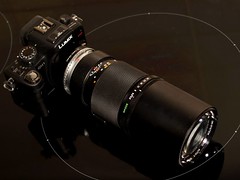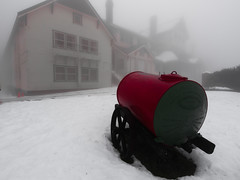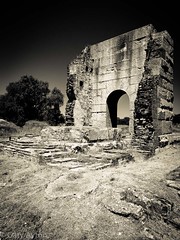As expected, Panasonic has released the specs of the GH-2 Micro Four Thirds camera which is essentially an upgrade of the current best hybrid video camera available – the GH-1 (best video quality if a still photography camera when updated with the hacked firmware which makes it better than any Canon or Nikon for HD video).
In addition to upgrading the video capabilities, it adds the touch LCD screen features of the G-2, increases sensor to 16mp while improving noise for better high ISO performance, and has a much faster sensor refresh which means better EVF image and faster AF.
The 16mp sensor (actually an over-sized 18.3mp to allow full 16mp images in either 4:3, 3:2 or 16:9 aspect ratios unlike most other cameras which achieve these aspect ratios by cropping) is a much more sensible approach than the leaked Canon mirror-less camera which is purported to have a rather silly 22mp in the same size sensor.
The sensor has faster sensor read-out promises faster AF and smoother viewfinder image – “The camera features the world’s fastest level Light Speed AF of approx. 0.1 second (to move the lens to “2m” from “infinity” position) which is achieved by reducing the detection time for focusing by doubling the drive speed from 60 fps to 120 fps”.
The new sensor technology employed means that not only does it produce high resolution but with excellent S/N with more than 3dB improvement of noise and 200% higher sensitivity. The ISO range is now up to 12,800. We will have to see the images to see how good this really is.
The mechanical shutter now allows 5fps at full 16mp resolution, but you can also choose a 4mp 40fps option using the electronic shutter (for 1 sec only, and as it is not yet a global shutter, there is effects of rolling shutter on panning at 40fps) .
The movie capabilities are perhaps the most exciting improvements:
- can take a 14 megapixel photo (16:9) while recording movie by just pressing a shutter button, plus you can save a frame of movie as photo during playback
- Extra Tele Conversion function virtually extends the zoom range up to 2.6x (presumably by using cropped sensor output for HD video and thus not losing any quality as with normal digital zoom)
- at last an exposure indicator warning of over-exposure during movie recording – “the wash-out areas are indicated with lighting highlight when recording movie”
- wind cut and stereo mic as for GH-1
- touch screen AF
- full HD 1920×1080/60i smooth, high quality movie recording with powerful 60p output (GH-1 recorded at 25p and produced 50/60i output)
- cinema-like 24p movie with the bit rate of max. 24 Mbps provides overwhelming image quality with richly expressive afterimage.
- new Cinema Mode – enables the movie to have a characteristic superior gradation.
- variable frame rate – It is possible to choose the suitable frame rate of the movie among 80%, 160%, 200% and 300% according to the recorded contents with the new Variable Movie mode.
- simultaneous HDMI output while recording images is convenient for even professional users to monitor images on a separate screen
- can now also record up to ISO 3200 in video mode
- 3D video capability via the new 3D lens
To me these represent a compelling upgrade if the purported improvements in image quality and AF speed are real and on paper easily beat the leaked offering from Canon.
I only wish they used this sensor in the Olympus E-5!
I presume that Panasonic have made the firmware a bit more difficult to hack this time, but at these capabilities, perhaps it will not need to be hacked!
From hands on review at Photokina:
- “There was not another DSLR at Photokina by Canon or Nikon that can compete as an all-rounder. The GH2 is a complete package.”
- “ISO 800 is silky smooth, it looks like ISO 200 on the GH1.”
- “On the GH1, the degradation happened between 800 and 1600 but on the GH2 it only goes down hill between 3200 and 6400 – a great improvement!”
- “AVCHD is fixed, no mud”
- “Pricing is very competitive, with the body only costing $900”
- “mage quality thanks to the new scaling chip and 3 core CPU looks to be a great step forward for the DSLR video world. The camera resolves a lot more detail than the Canon DSLRs or the Nikon D7000, which look very soft in comparison.”
- “the 5D Mark II is starting to look like a bit of a one-trick-pony in the same way that the D3S only does one thing well. Canon and Nikon just got beat and it’s time they responded.”
- “The image is free of moire and aliasing”
Users testing the GH-2 with the new 14mm f/2.5 state that the AF is FASTER than dSLRs such as Sony A55, Olympus E-5, Canon 5D Mark II and MUCH faster than Samsung NX10, NX100 and the Ricoh 28mm f/2.5 module.
Looks like Panasonic is onto a real winner here – by far the best video capabilities combined with great still image capabilities in a compact size and a reasonable price – now that is worth an upgrade if you are into video at all!
The faster AF, better EVF, best available unhacked HD video, reasonable high ISO performance, combined with all the benefits of compact mirror-less systems means this GH-2 is another nail in the coffin for Canon and Nikon in terms of the need for dSLRs for non-professionals, and shows mirror-less systems or at least mirror hybrid systems are clearly THE FUTURE of non-professional travel and advanced amateur photography.
And if you want to see how fast the AF is, check out this video, particularly the second half when it is used at 140mm focal length (ie. 280mm in 35mm terms) – now that is FAST!!











Darn – I wish they had stuck at 12 megapixel, and I wish they supported Tester 13’s Firmware hacks – or at least “ignored” them rather than trying to fight them – they also need a faster video-optimised zoom (aperture-wise) and no ridiculous regional coding … still, I have to say this is quite tempting as it is (and I’ll bet the strap loops don’t even fall off if you look at them sideways !) …
Yes Damen, I would have preferred to keep it at 12 megapixel but sales may be better if it is seen to be “competitive” at 16mp.
I would dearly love a wider aperture CD-AF capable zoom, but I suspect size may be an issue in which case I would be happy for a 100mm f/2.0 OIS macro instead.